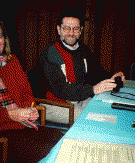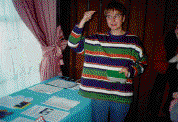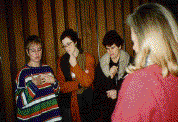


Children in our times need an education which refers to the
circumstances and conditions being. Progressive teachers at
European schools worked out models facing these challenges.
Here you will be introduced to the most important ones:
Here we deal with the necessity that students should actively do something, fulfill tasks during their lessons. As soon as we make this possible we give them chances to do something meaningful, something complete and something efficient.
Doing something actively means getting to know the world. Doing something we get a picture (pattern) of how we can do this. The language used during this act of doing supports all this as we have to "understand". Step by step we will less and less have to deal with practical actions because we know how to do them. We will act because of our imagination which is supported by language and so we will not be forced to do all these things practically. Education that aims at actions and tasks always starts with a project, a plan or a problem:
How do you make cookies ?
The tyre is flat, it has to be fixed.
Four children are to share 5 nuts.
After that the problem has to be transferred into actions and one has to work on it. It is important to get an imagination of all actions that have taken place and to be able to describe them using a language, because you should be able to know them using your brain not your hands.
The actual activity is the bridge between your imagination and knowledge and your practical ability. As the process "getting to know the world" does not happen automatically (nowadays children very often learn by using pictures, we have to give them practical support in our schools). That is the reason why it is most important to learn things in a concrete and practical way. Which actions are meant by "to break up the soil", "to lighten something", "to build something", "to plant something" or other more creative actions.
Practical learning
In Germany a group of scientists and practically working teachers at schools founded a movement called "practical learning". They support "projects of practical learning", which is supported by The Robert Bosch Foundation.
Practical learning means general education.


Dealing with this subject means to deal with senses we hardly use anymore (smelling, feeling (touching)), with movements and education on how to move and with comprehensive learning (with your head your heart and your hand) at school. All that learning is done by the whole individual, not only by a part of it. The more the human being learns something the more intensive this learning will be.
Learning with all of your senses first means a more intensive perception and finally a learning on different "channels" (channels of your senses).
Moreover children are more motivated to learn. Learning with all your senses means to try to create a closer connection between learning and natural learning (learning you practise out of school). The main subject is to teach movements systematically, because nowadays children do not move naturally. Educating movements contains different elements:
a) Exercises to perceive the body,
b) exercises to integrate both halves of the brain,
c) undirected exercises to make lessons become more relaxing,
d) integration of exercises of movements into lessons,
When dealing with plans for the week teachers' guidance and the
room for actions of the students are different with regard to the
extent:
there will always be the possibility to make the plan for the week
become more directed by the teacher. But more and more teachers
venture to give more room to their students.
Here is an example:
A teacher in Osnabrueck is working with her students on a plan for
a week, which contains tasks which have to be done and some tasks
which the students can choose if they like. Within some 4 to 6
lessons the plan has to be fulfilled.
In a common introduction the necessary elements with reference to
content, method and organisation are discussed and problems are
solved.
The students then work individually and at the end they meet to
have a discussion about the results.
More and more teachers start to delagate parts of the lessons to
the students' own responsibility. Doing that the common lessons in
a class normally become more relaxed. Students work according to a
plan which more or less was made in cooperation.
Undirected work then is a teaching which becomes more "material
oriented" and is conducted in firm sections of time. Each student
is responsible to do his own tasks.
In contrast to our ordinary experience in teaching children need silence. Here we deal with the subject of how situations and constellations will make such an experience of silence possible.
Two examples:
The ticking alarm clock
In the middle of a circle of sitting children there is an alarm clock.
Task:
The class has to be so quiet that the alarm clock can be heard on
a tape being recorded.
Variations:
The clicking noise of the alarm clock will be heard from a tape
that will be turned lower and lower.
This exercise will be integrated into a unit about time. The alarm
clock is hidden in a part of the room.
Dwarf and giant
A story of a dwarf and a giant is told. Whenever the giant appears the children pretend to be very big, whenever the dwarf appears they become very small. Finally both of them have a rest and dream.
Exercises in silence make children make intensive experiences
themselves, with others, with space and time or with things in
their everyday lives.
These exercises train their imagination and take back images and
feelings into lessons.
These exercises will even make the feeling of the group become
more intensive, if experiences become subjects of discussions.
Exercises of silence for many adults and youths are the first
encounters with their inner world, which can be wandered through
and which then will be known better.
First of all teachers have to encorporate silence themselves.
Space and order of seating are very important as well as a relaxed
athmoshere within the group.
Starting from exercises of silence will give way to encounter
meditation.
Teaching in projects respectively the project itself already contain many of the elements mentioned and show an integration of points already dealt with so far.
The typhoid project as an example:
What are the reasons for typhoid within the Smith family ? Within a small school in Colorado in 1927 children tell that repeatedly typhoid has come down on the Smith family. The students want to know the causes of that desease. By doing research, studying books, asking experts and doing other kinds of practical work the school in Collins is not only able to find out the causes but to fight effectively against the desease.
Elements of a project have to be seen as a guideline. They only can be realised to a certain extent.
Some more subjects of projects are:
(1.) Childhood
(own childhood - experiences and images, "literary childhood", the
parents' childhood, the grandparents' childhood etc). The result
should be a documentation or a book.
(2.) Weeks for projects in schools: subject: Europe
Single subjects can be:
Meals (food) in the European Union (EU),
tales in the EU,
songs,
typical clothing,
cars and their origin,
stamps of European countries,
special aspects within projects.
At the beginning of a project you should pay attention to:
Teaching guided by teachers has been and still is necessary. But
it can be improved.
The following aspects have to be kept into consideration and
should be realised in an optimal way:
According to empiric research it can be said that if all elements are guaranteed teachers will reach satisfaction very quickly.
Even the guided teaching can show undirected phases and situations. Students can be asked to plan an English breakfast, to search possibilities to get back a bird that flew away, to find a story.
Each teaching, which is meant to solve a problem or to discover something, shows some of those undirected phases as well as teaching in which students are asked to do something actively or in a task oriented way.